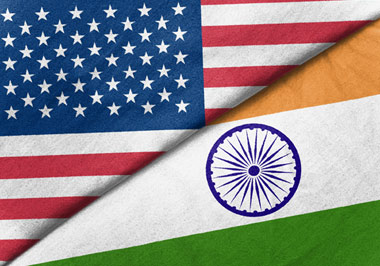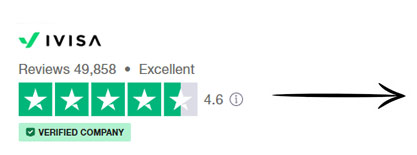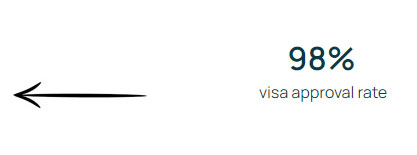How to get indian visa from USA?
If you are an US citizen wishing to visit India, you must obtain a visa before your departure. India offers a variety of visa options, including e-Visa, which is a convenient, fully online solution.
 Fast: Simplified, efficient process.
Fast: Simplified, efficient process.
 Security: information is protected.
Security: information is protected.
 Reliability: 98% approval rate.
Reliability: 98% approval rate.
 Assistance: 24/7 customer support.
Assistance: 24/7 customer support.


The types of visa available for India include tourist, business and medical visas, each with specific validity periods and conditions. For US citizens, the visa application can be made easily via the official portal or through a private service provider, and the processing time is generally fast, around 72 hours. This page will provide you with all the information you need to apply for an Indian visa, from the documents required to costs, including advice on how to avoid visa refusals. With this guidance, you can plan your trip with peace of mind and enjoy the incredible cultural and historical diversity that India has to offer.
Do US citizens need a visa?
- Requirement: US citizens must obtain a visa, whether paper or electronic (e-visa), before entering India.
- e-Visa: e-Visas are available for tourism, business and medical purposes, and can be obtained online.
- Price: the cost varies according to the type of visa requested. For example, a 30-day e-tourist visa costs between USD 10 and USD 25, depending on the season.
- Processing time: the processing time for an e-Visa is generally 72 hours or more.
- Period of validity: the e-Tourist visa may be valid for 30 days, one year or five years, depending on the user's choice.


For US citizens, applying for an eVisa for India is a simple process that takes place entirely online. The eVisa is available for several types of stay, including tourism, business, and medical care. Here are the steps to follow to apply.
Documents required by US citizens to apply for an India tourist visa
To obtain an India eVisa, US citizens must provide the following documents:
The price of the eVisa depends on the type and duration of visa requested. For example:
US citizens can easily submit their eVisa application via the Indian government's official portal or through an assisted private service provider.
The processing time for obtaining an eVisa to India as a US citizen is generally quick and convenient. Once the application is submitted online through the official portal, it is usually processed within 72 hours. However, this time may vary depending on the volume of applications and the time of year. Travellers are advised to apply for an eVisa at least four days before their planned departure date to ensure that their visa is received on time.
For 30-day e-Tourist Visa applications, travellers can submit their application up to 30 days in advance of their expected date of arrival, while for longer tourist visas (one year or five years), the application can be made up to 120 days before travel. Applications submitted in advance minimise the risk of delays due to missing documents or administrative errors.
If processing takes longer than expected, applicants can track the progress of their application on the portal using the ‘Check your visa status’ option. If they have any questions, applicants can also contact the eVisa helpdesk via the e-mail address or telephone number provided on the official website.
Visas for India offer varying flexibility in terms of duration and validity, allowing US citizens to choose a visa that suits their needs, whether for a short stay or for regular visits.
US citizens opting for an e-Tourist Visa have several options when it comes to the number of entries:
eVisas for India are neither renewable nor convertible. Once the validity of the visa has expired, US citizens must leave the country and submit a new visa application if they wish to return to India. For longer stays, it is advisable to reapply after leaving India.
Although the majority of visa applications for India are accepted, some applications may be refused. Visa refusals are often due to errors or non-conformities in the application. Here are some common reasons for refusal and what you can do if you are refused:
In the event of a refusal, it is possible to submit a new application after rectifying the errors or providing the missing documents. It is also advisable to contact the Indian authorities or the visa processing centre to obtain more precise information about the reasons for the refusal. This will ensure that the same mistakes are not repeated the next time the application is submitted.
India is generally considered a safe destination for US citizens, but as with any trip abroad, it is advisable to take certain precautions. India attracts large numbers of tourists every year, and the majority of visits are uneventful. However, it is important to remain vigilant, especially in large cities and busy tourist areas.
To ensure their safety, US citizens should follow local safety guidelines and avoid high-risk areas, particularly certain border regions or specific areas of Jammu and Kashmir, which may be subject to geopolitical tensions. It is advisable to follow the travel advice provided by the US Department of State, which issues regularly updated recommendations on the security situation in India.
In addition, it is advisable to take health precautions, such as protecting yourself from mosquitoes in areas where vector-borne diseases such as dengue fever or malaria are present. US citizens should also be vigilant about their valuables, especially in crowded areas such as markets and railway stations.
Find out if your question has been answered in the list below
No, US citizens cannot obtain a visa on arrival in India. They must obtain an eVisa or a paper visa before travelling. The eVisa can be applied for online via an approved Indian government website, which simplifies the process for travellers who need to ensure that they meet all the necessary requirements before departure.
In addition to a visa, US citizens must bring several other documents with them to enter India. A passport valid for at least six months beyond the date of entry is required, with at least two blank pages for immigration stamps. Travellers must also be able to show a return or onward ticket, proving that they will be leaving India. Finally, it is advisable to have proof of sufficient funds to ensure that the stay can be financed independently.
Yes, every US citizen, including children, must have a visa to enter India. Children must have their own passport and an individual visa. This means that parents must make a separate eVisa application for each child accompanying them on the trip.